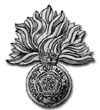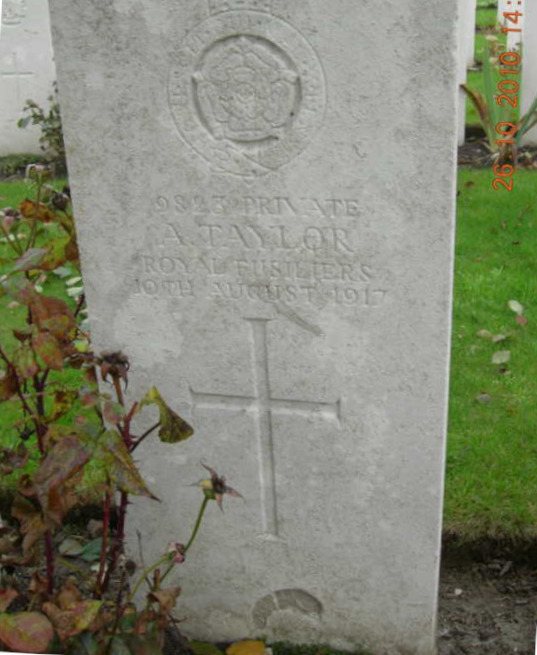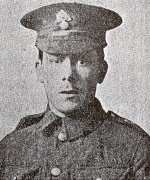LEATHERHEAD WAR MEMORIALS - WWI
Private Alfred or Albert? James Taylor
11 Bn Royal Fusiliers
Town Memorial P8.R4.C1

Taken, Not Given, Liam Sumption, L&DLHS
PrivateAlfred J Taylor
11th Royal Fusiliers
Glencorse Wood
Aug 10 1917
The War Memorial to the Royal Fusiliers in Holborn Circus states that 25,000 Royal Fusiliers died in the Great War. Reading the Royal Fusiliers' section of Soldiers Who Died in the Great War is literally like looking at whole battalions (sometimes twice over) of dead men.
It is frankly appalling.
The regimental records give the following details of Alfred Taylor. His second name was James and though born in Westgate [sic] (Surrey) he had enlisted in Leatherhead. His regimental number was 9823 and both his membership of the 11th Battalion Royal Fusiliers and the date on which he was 'killed in action' are confirmed.
Notes on sources
Soldiers Who Died in the Great War (Royal Fusiliers) – Royal Fusiliers' Museum, H.M. Tower of London.
The reference for the War Diary of the 11th Bn. Royal Fusiliers in the Public Record Office is W0 95–2045.
Further research
| Private TAYLOR, A Service Number 9823 Died 10/08/1917 11th Bn. Royal Fusiliers Buried at HOOGE CRATER CEMETERY Location: West-Vlaanderen, Belgium Cemetery/memorial reference: VI. K. 12. The inscription on his headstone
reads:
9823 PRIVATE
A TAYLOR ROYAL FUSILIERS 10TH AUGUST 1917 |
 image: Marion Haines 26 10 2010 |
 image: Leatherhead & Dorking Advertiser 26 June 1915 |
According to his Medal Card Alfred James Taylor initially joined the 4th Battalion Royal Fusiliers, apparently landing in France with them on 2 May 1915.
The 4th Bn, part of the 9th Brigade of the 3rd Division, mobilized for war on 13 August 1914. The 3rd Division landed at Havre, one of the first to arrive, and remained on the Western Front for the duration of the war.
In 1915 it saw action in the Winter Operations 1914-15, the First Attack on Bellewaarde, the actions of Hooge, and the Second Attack on Bellewaarde.
In 1916 it was involved in the Actions of the Bluff and St Eloi Craters, the Battle of Albert, the Battle of Bazentin, the Battle of Delville Wood, and the Battle of the Ancre.
It is not known when Alfred was transferred to the 11th Battalion, Royal Fusiliers.
The 11th Bn was formed at Hounslow on 6 September 1914 and came under the command of 54 Brigade, 18th (Eastern) Division. The division initially concentrated in the Colchester area but moved to Salisbury Plain in May 1915. They proceeded to France in July, landing at Boulogne and moved to Flesselles on the Somme where in 1916 they were in action in the Battle of Albert, capturing their objectives near Montauban.In 1917 they took part in the operations on the Ancre including Miraumont and the capture of Irles: they fought during the German retreat to the Hindenburg Line and in the Third Battle of the Scarpe before moving to Flanders.
There they were in action in the Battle of Pilckem Ridge
and the Battle of Langemarck during the Third Battle of Ypres (31 July
to 10 November 1917), a major British offensive also known as
Passchendaele. In over 100 days of fighting no strategic breakthrough
was achieved and the five-mile advance left the British in occupation of
an enlarged and highly vulnerable salient, at a cost of an estimated
250,000 casualties.
Alfred was one of them. He died on 10 August 1917 and is buried at Hooge Crater Cemetery.
sources: Leatherhead in the Great War: Lorraine Spindler; Ian Whitlock: Forces War Records
The 11th Battalion's War Diary (WO-95-2045) has a report on the action
in which he was killed:
"REPORT ON OPERATIONS OF 9TH/10TH AUGUST 1917
FORMING UP FOR THE ATTACK
Tapes were laid in "no mans land" for the troops to form up on. The 11th
Royal Fusiliers boundaries were from J.13.b.8.3 on left to J.15.d.9.6 on
the right.
ZERO The kickoff at "Zero" was
good with touch on left flank. On the right the 7th Queens Regt were
late in starting and were 100 yards behind the line of the 11th Royal
Fusiliers first wave.
The companies were in position in good time.
FORMATION
"B" and "D" Companies in front in two waves, "Moppers up" behind first
wave.
"C" Company in Support along Battalion frontage.
"A" Company in reserve behind "C" Company.
OBJECTIVES
The two attacking Companies and the Support Company reached the JARGON
SUPPORT LINE from J.14.b.0.5. to about J.14.b.3.0. just north of
FITZCLARENCE FARM.
The right attacking Company with its supports lost direction to a certain extent and did not occupy about 150 yards of trench on the right of the Battalion frontage.
A party of the 7th Queens Regt moved on the right flank of the 11th Royal Fusiliers, but were not seen on the objective.
The objective was reached in good order and close behind the barrage, but came under destructive frontal machine-gun fire. Time about 5.5 am.
The Lewis Gunners of the 11th Royal Fusiliers and the 6th Northamptonshire Regt clearing party came into action here in the attempt to counter the enemy's Machine Gun fire and snipers,
The position remained the same until about 6 am by which time all the Officers and many of the NCO's were casualties.
Tthe enemy then developed a well planned counter-attack from INVERNESS COPSE supported by strong Machine Gun fire. The attack took the form of bombing up trenches from the Southern flank and also took our right company in rear.
The effect was the uncovered flank of the Battalion was rolled up and driven back to the crest line of the strong point in J.14.a. which was consolidated and held until the Battalion was relieved by the 8th Norfolk Regt.
The reserve Company in the attack reached its objective on the light railway line running by the farm in J.14.a. This turned out to be a very exposed position on the forward slope and became untenable when the Germans counter-attacked from the Copse. This company commander A/Capt FWE HOARE withdrew to the crest line mentioned and reorganised the Battalion until he was killed.
The main cause of the Battalion being unable to remain on its objective was the enemy being in possession of our right flank. This extended for 700 yards and the Germans had that space to manoeuvre in against our flank and rear.
All the Officers and senior NCO's becoming casualties just before the critical moment a very dangerous situation remained uncounteracted for want of leaders.
There was a remarkable amount of rifle ammunition used in this battle and Lewis Guns that survived used all their drums before returning."
Although hard to make out the War Diary appears to state that "The Battalion Strength on going into action was 37 Officers and 891 Other Ranks. Strength on coming out of action was 20 Officers and 563 Other Ranks."
His life
For his genealogy see The
Taylor Family
In April 1914 his marriage to Edith May Shepherd was registered at
Reigate, Surrey.
Edith was born on 29 October 1895 and baptised on 23 February 1896 at Leatherhead Parish Church. Her father, who died before she was married, was Herbert Shepherd, born Littleton, Mids [sic], at various times a Whitesmith and a Gas & Water Engineer. Her mother Jane was from Coleshill, Wiltshire. The Shepherds lived in Leatherhead in Kingston Road and North Street.
Alfred and Edith had two children - Alfred Frederick
Herbert b 1914 and Edith Louise (1915-1918).
After the war
Edith married again in January 1920 to William T Small, registered at
Epsom, Surrey.
Her death at the age of 87 was registered in Surrey Mid Eastern District
in January 1983.
Alfred is remembered on these memorials
Leatherhead Town Memorial
Leatherhead RBL Roll of
Honour, Leatherhead Parish Church
Ladies War Shrine, Leatherhead
Parish Church
Church Lads Brigade Memorial
Tryptich, All Saints Leatherhead
Surrey
in the Great War
the website editor would like to add
further information on this casualty
e.g. other photos of him, and of any recollections within his family
last updated 11 Aug 20: 1 Jan 21